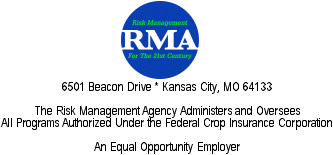

INFORMATIONAL MEMORANDUM: R&D-99-033
TO: All Reinsured Companies
All Risk Management Agency Field Offices
FROM: Tim B. Witt /s/ Vondie O'Conner (for)
Deputy Administrator
SUBJECT: Conversion of Texas Citrus Fruit to Actual
Production History (APH)
BACKGROUND:In 1989, a major freeze severely damaged Texas citrus trees causing Texas citrus fruit yields to be determined using the "appraisal" method. For the 2001 crop year, the Risk Management Agency (RMA), will discontinue setting Texas citrus fruit yields by field appraisal and transition to approved yields determined under the APH program. Citrus groves have recovered from the 1989 freeze and yields have stabilized sufficiently to allow this conversion.
Producers were notified by the 1998 Texas Citrus Fruit Policy to keep production records for APH purposes. The Oklahoma City Regional Service Office (RSO) also informed all companies in the region to request production records from their insureds for future APH yield calculations.
In preparation for the conversion, RMA has established separate "T" Yields for Oranges (0224 and 0225) and Grapefruit (0226, 0228, and 0238) by "years" (the number of crop years following the year of set out or dehorning) and updated the 2000 Crop Insurance Handbook (CIH) to provide that Texas citrus fruit yields will be determined using APH for the 2001 crop year. The CIH also includes pre-acceptance field inspection forms, underwriting forms, APH and other general instructions for Texas citrus fruit.

The following procedures provide for conversion of Texas citrus fruit yield determinations to APH beginning with the 2001 crop year. Insurance providers must:
1 Notify each Texas citrus fruit policyholder, prior to the contract
change date, that:
A Approved yields will be calculated using APH procedures instead of
appraisals made by the RSO.
B Production reports must be submitted that include harvested
production and insurable acreage information for previous crop years.
This information will be used to determine policyholders' approved
APH yields; however, the reported production must be supported by
verifiable records from a warehouseman or buyer of the insured crop.
If acceptable production reports are not provided, a yield equal to
the prior year's appraised yield may be used to determine the 2001
APH Yield; and
C Policyholders will be required to complete Producer's Pre-Acceptance
Worksheets annually and submit them to the insurance provider.
Failure to timely submit a properly completed Pre-acceptance
Worksheet may result in denial of coverage.
2 Use the Following Procedures for Carryover Insureds:
A For Underwriting and APH Responsibilities, refer to Sec. 5 of the CIH.
B For Pre-Acceptance Field Inspections and Pre-Acceptance Field
Selection Criteria, refer to Sec. 7, Par. 7F of the CIH.
C For APH Field Review Information, refer to Sec. 14 of the CIH.
D Insurance providers must obtain properly completed Pre-Acceptance
Worksheet(s) from each insured. Refer to Sec. 7, Par. 7E
of the CIH for additional instructions.
E Production reports submitted must begin with the 1999 crop year.
ALL crop years submitted must be continuous (i.e., 1999,
1998, 1997, etc.).
F 2000 crop year approved yields (RSO 2nd stage appraised yields) are
considered RSO Determined Yields (RSO DY's) and will be used to
complete APH databases when carryover insureds provide fewer than
4-years of acceptable production reports containing actual
yields (by unit/block/database). (Carryover insureds WILL NOT
have the option of using "T" yields instead of RSO DY's.)
In subsequent crop years, RSO DY's will be replaced by actual or
assigned yields. Assigned yields will apply if the policyholder
fails to provide production reports as required by the
Basic Provisions.
Example: If the policyholder provides acceptable production
reports for 1999 and 1998, two actual yields and two
RSO DY's (for 1997 and 1996) are entered in the
database (the yield column) for the respective years.
RSO DY's are preceded by "F" yield descriptors.
Example: If the policyholder DOES NOT provide any acceptable
production reports, four RSO DY's are entered in the
database (yield column). RSO DY's are preceded by
"F" yield descriptors.
Exceptions to RSO DY's:
(1) Trees have been dehorned since the RSO appraisal (such acreage
is not insurable until it produces and avereage yield of at
least three tons per acre after dehorning),
(2) Added land or added insurable acreage (including units/blocks
that were inspected and coverage was denied for the 2000 crop
year). For these situations an RSO DY is not available;
therefore, insureds must submit acceptable production records
or the company must perform a crop inspection and appraise
the acreage. Such acreage must have produced an average
of at least three tons per acre the previous crop year or it
must appraise at least three tons per acre for the current
crop year to be insurable. For detailed added land and added
insurable acreage instructions refer to CIH, Sec. 7, Par. K.
If added to an existing unit, Block Production Worksheets and
a Unit Summary will be required to calculate a weighted average
yield. (Refer to the CIH, Sec. 7, Par. I for additional
information.)
(3) A claim for indemnity was filed for any of the four most recent
crop years contained in the APH database. The actual production
history from the claim for indemnity MUST be used for the
appropriate crop year if a break in continuity of insurance
has not occurred since the claim was filed.
G CUPS and CAPS will apply to units/databases (with approved APH yields
for the prior crop year) if a carryover insured provides production
history for the most recent crop year (1999). If more than one
crop year of production history is provided, CUPS and CAPS will
not apply.
H Assigned Yields will be applicable beginning with the 2002 crop year,
if acceptable production reports are not provided for the 2000
crop year. The assigned yield will be 75 percent of the prior year's
(2001) approved APH Yield.
I Acceptable production records. For production delivered or sold
to a packer or processor, refer to Sec. 7, Par. L(4)(b) of the CIH.
For production marketed directly to consumers, refer to
Sec. 10, Par. C(4)(e) of the CIH.
4 Use Standard Category C APH Procedures for New Insureds.
Refer to the CIH for:
A Underwriting and APH Responsibilities (Sec. 5).
B Category C APH Procedures (Sec. 7).
C APH Field Review Information (Sec. 14).
D Pre-Acceptance Inspection Reports, Block Production Worksheets,
and Unit Summary Worksheets (Exhibit 16).
5 For the 2002 Crop Year, follow standard APH procedures contained in
the Crop Insurance Handbook.
DISPOSAL:
This informational memorandum is effective for the 2001 Texas citrus fruit crop year; therefore the disposal date is November 21, 2000, for administrative tracking purposes.